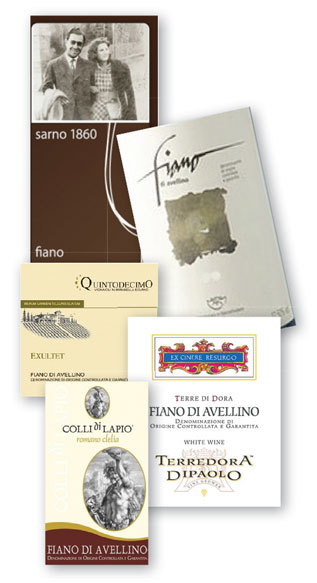I first walked into A16’s bustling, wood smoke–scented dining room in the spring of 2005, fresh from living in Italy. A powerful case of Rome-sickness stung my new life in San Francisco, and familiar names like fior di latte, bucatini and fiano helpedto make that transition smoother. I dove eagerly into the restaurant’s beautifully rendered southern Italian cooking.
But more than that, it was the immediate warmth of the restaurant that put me at ease. The source of that warmth was apparent as soon as I opened the wine list: Shelley Lindgren, the owner and wine director, came to the table to share stories about the producers represented there.


Lindgren quickly directed us to the fiano from Clelia Romano, a flint-edged pour that felt deep and thoughtful in its expression yet paired joyfully with our food. I’d had plenty of fiano in Rome by the carafe at outdoor cafés, but this was on a higher level.
Fiano hails from the southern Italian region of Campania, much of which is mountainous and marked by eons of volcanic activity; back in the 1990s and early 2000s, not much wine left the immediate area. “Growers in the region were too poor to get into the cabernet and chardonnay game like Tuscany,” says Lindgren. “Yet wine has always been a huge part of what they do.”
Recently I sat down with Lindgren at the back of A16 as cooks and sta prepped for service. She recalled the planning stages of the restaurant: Christophe Hille, A16’s opening chef, had been traveling in Italy for research and had shifted his focus south to the cuisine and pizza of Campania. Lindgren soon joined Hille in Italy and it was on that trip that she first had fiano from Clelia Romano. The lightbulb went off.
“Without Clelia’s wine, and maybe a Taurasi, there may never have been a southern Italian [wine] focus at A16,” Lindgren says. For a restaurant named after the main highway running through Campania, that’s saying a lot. “We’ve had Clelia’s fiano on by the glass since we opened, and now the whole staff calls it ‘Clell’s Bells.’”
Lindgren plunged into fiano with gusto, exploring wines from the hilly, inland region of Avellino, the traditional home of fiano, as well as renditions from the southern coastal vineyards of Campania. Lindgren now features more than a dozen expressions of fiano at A16, including some rare sparkling versions. “We feel this is one of the most important grapes on our list, and we always have a few by the glass,” she says. Initially guests would be looking for more familiar choices like sauvignon blanc or chardonnay, and Lindgren would encourage them to check out fiano. “Suddenly we had regulars coming back and asking for these wines.”
“The very first winemaker dinner we did at A16 was with Lucio Mastroberardino [of Terredora di Paolo], and I remember him standing up and declaring to the room that fiano is the greatest white wine grape in the world,” Lindgren recalls. “And now I really get it; there’s all of the acid and complexity to age beautifully, and there’s such depth and energy to the wines.” These six bottlings have become her touchstones—wines that capture the profound, tensile depths of fiano at its best.
1. Terradora di Paolo Fiano di Avellino
“I always think of driving to visit the late, great Lucio Mastroberardino and passing an endless row of torrone [confection] manufacturers and thinking of api, the Latin word for bees, and likely the root for the word Lapio, the home of fiano. Back when we opened, Terradora di Paolo made fiano in a round and rich style more similar to typical chardonnay; today it’s slightly leaner in style but still complex, with notes of McIntosh apple, cantaloupe, basil and Meyer lemon.”


2. Clelia Romano Colli di Lapio Fiano di Avellino
“Literally and fi guratively the matriarch of fiano, and a benchmark for quality, balance and Lapio’s volcanic minerality, this fiano was one of the wines that helped define the southern Italian focus of our list at A16. It’s also one of my favorite wines to pair with artichokes, which are everywhere in central and southern Italy in spring. It follows the idea of ‘grows together, goes together.’”
3. Ciro Picariello Fiano di Avellino
“The high elevation of Picariello’s Avellino vineyards helps to explain why this region has one of Europe’s longest growing seasons. While there is no shortage of hot summer days, thanks to elevation and vine stress, this fiano has all the delicacy and verve of cool-climate whites.”
4. Pietracupa Fiano di Avellino
“Sabino Lo redo is on my short list of the great Italian white winemakers. His humble and relaxed nature just makes the hard work of farming and viticulture look easy. With winemaking talents like his, I’d trust any wine or vintage he makes. His fiano typically balances volcanic smokiness with a distinctive evergreen freshness that matches the intensity of squid-ink pasta dishes.”
5. Sarno 1860 Fiano di Avellino
“A new addition to the by-the-glass fiano rotation at A16, this is a wonderful, classic expression from Avellino. It has a richness of fruit (Gala apple, honeydew melon) balanced with notes of fresh almonds and lively minerality.”
6. Quintadecimo Exultet Fiano di Avellino
“Named for medieval liturgical parchments found in southern Italy, this [single-vineyard wine] has become a ‘grand cru’ of fiano, made by Luigi Moio, a winemaker and professor at the University of Naples specializing in the indigenous grapes of Campania. Exultet shows finesse, complexity and staying power in ways that really elevate fiano di Avellino.”
This story was featured in W&S Fall 2016.
illustration by Gavin Reece
Based in San Francisco, Wolfgang Weber was the Italian wine critic at W&S. He now works with the Revel Wine and Selection Massale, and continues to write freelance. Nebbiolo is his spirit grape but if he were to live anywhere in Italy, he’d choose Liguria.
This story appears in the print issue of fal 2016.
Like what you read? Subscribe today.















